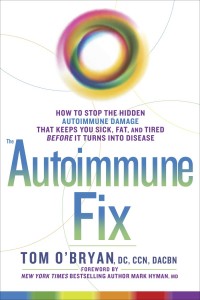Has Wheat Been Found Guilty Without a Fair Trial?
Excerpted from Eat Wheat
Has gluten been found guilty without a fair trial? It wouldn’t be the first time an innocent food was given a life sentence. For example, after almost 60 years of so-called “hard science” condemning cholesterol, we now find out that the interpretation of the science was flawed and high cholesterol saturated fats, such as butter, have been officially taken off the FDA’s nutrient concern list.
Is it possible that we have wrongfully given gluten the boot as well, along with dairy and other commonly allergenic foods such as eggs, soy, corn, fish and nuts?
Today, there are millions of people without celiac disease or severe dairy allergies who are electing to be gluten-free and/or dairy-free, not because they are actually allergic to these foods, but because of their food sensitivities, or simply because these foods have been labeled as dietary “no-no’s.” It is the aim of this book to share the compelling scientific and clinical evidence that gluten—along with other specified foods, such as dairy—is often not the underlying issue in the case of digestive woes and food sensitivities.
For many, the underlying issue is actually a broken down digestive system caused by:
- Overeating certain food groups, resulting in inflamed skin that lines the intestinal tract.
- Making poor food choices that slowly break down digestive strength and gut health.
- Preparing and eating certain foods at the wrong times and in the wrong ways.
- Eating out of season.
- Eating commercially processed bread and dairy that contains herbicides, pesticides (sometimes even genetically engineered pesticides), antibiotics, preservatives, cooked oils and growth hormones that our bodies were never designed to digest.
All of these actions compromise our digestive strength. It’s no wonder so many people are no longer able to properly digest these foods!
A Brief History of Gluten
It’s important to know that gluten is not the new kid on the block. There is archeological evidence of flour from wild cereal grains made in (what is now) Europe from around 30,000 years ago, during the Upper Paleolithic era. (22) And, around 10,000 years ago, with the widespread rise of farming and agriculture during the Neolithic era, bread and cereals became seasonal dietary staples. (1-3)
Contrary to what we have been led to believe, our early ancestors may have eaten much more grass, grain and wheat than previously thought, as the Ice Age forced them to venture out of the tropical rain forests into the grassland savannas, and look for new food sources.
Field studies have shown that a human can gather enough wheat berries from a field to supply enough nutrition for the entire day in just 2 hours, so why wouldn’t early humans gather the easy-to-obtain grains from the grasslands as a mainstay of their diet? New findings suggest they did. (4,5)
In the same groundbreaking report out of the University of Utah, the earliest evidence of human ancestors scavenging already-dead meat did not appear until 2.5 million years ago. Moreover, definitive evidence that humans hunted for their food does not appear until 500,000 years ago. (6,7)
As for our direct human ancestors, this study suggests that about 3.4 million years ago, the hominin, Australopithecus afarensis and other human relatives ate, on average, 40 percent grasses, which included gluten rich barley and wheat. By 1.7–2 million years ago, early humans ate 35 percent grasses and some scavenged meat from grazing animals, while another nearby hominin, Paranthropus boisei, was eating 75 percent grasses, including wheat.
To be precise, according to the science, we should be making the case that humans have less genetic experience eating meat than we do wheat. (6,7)
As the studies show, humans have been eating gluten for a very long time. Why is it that, suddenly, after so many thousands or millions of years of eating wheat and other glutinous grains as in-season dietary staples, eating a gluten-free diet is now one of the most prominent dietary trends?
As a strong digestive system is required to break down and eliminate ingested environmental chemicals and pollutants—which are, yes, even on your organic produce—healing the digestive system is more important now than ever before. A new EPA analysis reports that almost 4 billion pounds of chemicals—62 million of them carcinogenic—are released into the environment each year in the U.S. alone. (9)
If you cannot tolerate wheat and dairy now, but once could, or you have found yourself slowly removing foods from your diet over the years, then this may be a sign that your ability to both digest and detoxify is compromised, which also puts you at risk for unnecessary exposure to the dangerous chemicals and toxins in our environment.
Some Facts, For Starters
While this subject is hotly debated, there is good science suggesting the original wild wheat, with less exposure to the environmental toxins of our modern world, may have had gluten levels that reached almost twice the amount of gluten in today’s wheat! (1,8) Suggesting that, based on gluten levels alone, the original wild wheat was a much harder grain to digest compared to today’s wheat.
When researchers compared the gliadin components of gluten from 2 ancient wheat varieties, Kamut and Graziella Ra with modern varieties, the ancient wheats had total gliadin and alpha-gliadin levels that were almost twice as high as the modern wheat varieties. Alpha-gliadin is considered the indigestible toxic form of wheat that is linked to many of the gluten sensitivity symptoms. (1,8)
In another study, inflammation markers were measured on 22 people who ate either the ancient wheat, Kamut, or a modern wheat strain for 8 weeks. The group that ate the Kamut, where they found almost twice the amount of toxic gliadins in the previous study, saw a more than 2 times reduction in the common inflammatory markers associated with gluten sensitivity compared to the group that ate the modern wheat. How could the wheat with the highest toxic gliadin levels be almost twice as anti-inflammatory as the wheat with the least amount of gluten and gliadins? (10)
In that same study, the Kamut lowered total cholesterol, fasting blood sugar and increased magnesium and potassium levels in the blood compared to the modern wheat, suggesting that the ancient wheats are a much better choice, even though they may have more gluten and gliadins. (10) I agree.
Here is the scenario we find ourselves in: We are blaming gluten and it’s gliadins as the cause of our digestive imbalances, yet ancient wheat may have had almost twice the gluten that modern wheat does, and people have been eating gluten for millions of years. How could it be that suddenly gluten has become such an issue? How could our modern gluten be solely responsible for the recent litany of health concerns and food sensitivities?
Ancient grain varieties were also traditionally prepared differently. They were often soaked, sprouted, and fermented before consumption, rendering them easier to digest and increasing their nutritional value. These practices, which are also in use today, can almost completely break down gluten, boost mineral content, increase levels of amino acids like lysine that make nutrients more easily absorbed and break down anti-nutrients like phytic acid. (11-13)
Certain studies show that although there has been an increase in celiac-based gluten intolerance in the second half of the 20th century,32 there is no evidence that this rise is due to an increase of the gluten content in wheat. In fact, according to a 2013 study in the Journal of Agriculture and Food Chemistry, the gluten content in wheat during the 20th and 21st century has been relatively stable since wheat processing began in the late 19th century, and the average consumption of wheat flour in America has decreased by a whopping 86 pounds per person per year from the year 1900–2008. (1)
Toxins and Sugar: Guilty as Charged
Early farmers who first domesticated wheat selected seeds that were larger and easier to remove when threshing. The larger the wheat seed, the more starch (sugar) and less protein the grain had. Since the gluten content in wheat is proportional to the protein content, ancient domesticated wheat gradually increased in sugar content while decreasing in gluten, gliadins and protein. (1)
As wheat became increasingly processed, the glycemic index (how quickly a food breaks down and enters the bloodstream, creating a rise in blood sugar) of commercialized wheat products spiked. For example, a slice of processed white bread or large dinner roll is about a 70 on the glycemic scale, while a slice of 100 percent stone-ground whole wheat or pumpernickel rates in at about 55.
The famed “wheat belly” is better termed “sugar belly” as many of the wheat sensitivities and studies linking gluten to these health concerns are more a result of excess sugar. Refined carbohydrates, such as processed white bread, quickly convert to sugar in the bloodstream.
This explosion of sugar from a high glycemic diet can cause every single symptom we have that is currently linked to gluten. In fact, much of the science supporting the grain brain theory, which links wheat to an increased risk of dementia, was based on the effect of sugar on the brain rather than the wheat itself. The theory suggested that wheat (and all grains for that matter) is the cause of high blood sugar and, thus, the smoking gun for Alzheimer’s disease. This theory is challenged by a number of studies that show wheat actually lowering blood sugar (14-17) and reducing the risk of Alzheimer’s. (23-28) Have we once again condemned an innocent grain, like we did with cholesterol, to the dangerous foods list, based on a flawed interpretation of the science?
Processed foods, preservatives, pesticides and toxins in the environment that filter into our food supply present a causative problem. Studies tell us that these toxins can change the proteins in wheat, (18-20) and wreak havoc on the helpful enzymes in our bodies that break down gluten and other hard-to-digest proteins. (21)
The good news: We have the ability to detoxify the toxins in foods, but it requires a strong digestive system. (22) Remember, the very same channels that help us digest foods like wheat and dairy are used by the body to detoxify environmental toxins.
So, while you may do your best to eat healthy, non-processed foods, it is my mission to help you learn how to boost your digestive and detoxification potential. It is your birthright to live a long, healthy, happy life, break bread and enjoy a freshly baked slice of bread with butter.
References:
- Kasarda DD. Journal of agricultural and food chemistry. 2013;61(6):1155-9.
- Eitam D, Kislev M, Karty A, Bar-Yosef O. Experimental Barley Flour Production in 12,500-Year-Old Rock-Cut Mortars in Southwestern Asia. PloS one. 2015;10(7):e0133306.
- Vigne J-D, Briois F, Zazzo A, Willcox G, Cucchi T, Thiébault S, Carrère
I, Franel Y, Touquet R, Martin C. First wave of cultivators spread to Cyprus at least 10,600 y ago. Proceedings of the National Academy of Sciences. 2012;109(22):8445-9.
- donmatesz.blogspot.com/2011/06/gathering-wild-grains.html
- Council BoSaTfIDNR. Lost Crops of Africa: Volume I: Grains. Washington, C.C.: The National Academies Press; 1996
- archive.unews.utah.edu/news_releases/agrassy-trend-in-human-ancestors-diets/
- http://doi.org/10.1073/ pnas.1006993107.
- Gregorini A, Colomba M, Ellis HJ, Ciclitira PJ. Nutrients. 2009;1(2):276-90.
- http://www.mountsinai.org/patient-care/serviceareas/children/areas-of-care/childrens-environmental-health-center/ childrens-disease-and-the-environment/children-and-toxic-chemicals.
- Sofi F, Whittaker A, Cesari F, Gori A, Fiorillo C, Becatti M, Marotti I, Dinelli G, Casini A, Abbate R. Characterization of Khorasan wheat (Kamut) and impact of a replacement diet on cardiovascular risk factors: cross-over dietary intervention study. European journal of clinical nutrition. 2013;67(2):190-5.
- Gunnars K. Why Modern Wheat is Worse Than Older Wheat: Authority Nutrition; 2014. Available from: http://authoritynutrition.com/modernwheat-health-nightmare/.
- Azeke MA, Egielewa SJ, Eigbogbo MU, Ihimire IG. Effect of germination on the phytase activity, phytate and total phosphorus contents of rice (Oryza sativa), maize (Zea mays), millet (Panicum miliaceum), sorghum (Sorghum bicolor) and wheat (Triticum aestivum). Journal of food science and technology. 2011;48(6):724-9.
- Di Cagno R, Rizzello CG, De Angelis M, Cassone A, Giuliani G, Benedusi A, Limitone A, Surico RF, Gobbetti M. Use of selected sourdough strains of Lactobacillus for removing gluten and enhancing the nutritional properties of gluten-free bread. Journal of Food Protection®. 2008;71(7):1491-5.
- Fleischer DM, Bock SA, Spears GC, Wilson CG, Miyazawa NK, Gleason MC, Gyorkos EA, Murphy JR, Atkins D, Leung DY. Oral food challenges in children with a diagnosis of food allergy. The Journal of pediatrics. 2011;158(4):578-83. e1.
- Pediatrics FMNi. ‘Shotgun’ skin prick testing for food allergy held flawed: PM360online.com; 2014. Available from: https://www. pm360online.com/shotgun-skin-prick-testing-for-food-allergy-heldflawed/.
- Imai T, Yanagida N, Ogata M, Komata T, Tomikawa M, Ebisawa M. The Skin Prick Test is Not Useful in the Diagnosis of the Immediate Type Food Allergy Tolerance Acquisition. Allergology International.
2014;63(2):205-10.
- Education FAR. Skin Prick Tests: FoodAllergy.org; 2015. Available from: http://www.foodallergy.org/diagnosis-and-testing/skin-tests.
- Gunnars K. Mediterranean Diet 101: A Meal Plan That Can Save Your Life: AuthorityNutrition.com; 2015. Available from: http:// authoritynutrition.com/mediterranean-diet-meal-plan/.
- Solfrizzi V, Panza F, Frisardi V, Seripa D, Logroscino G, Imbimbo BP, Pilotto A. Diet and Alzheimer’s disease risk factors or prevention: the current evidence2011.
- Wengreen H, Munger RG, Cutler A, Quach A, Bowles A, Corcoran C, Tschanz JT, Norton MC, Welsh-Bohmer KA. Prospective study of dietary approaches to stop hypertension–and Mediterranean-style dietary patterns and age-related cognitive change: the cache county study on memory, health and aging. The American journal of clinical nutrition.
2013:ajcn. 051276.
- Samsel A, Seneff S. Glyphosate, pathways to modern diseases II:
Celiac sprue and gluten intolerance. Interdisciplinary toxicology. 2013;6(4):159-84.
- Agarwal R, Goel SK, Behari JR. Detoxification and antioxidant effects of curcumin in rats experimentally exposed to mercury. Journal of Applied Toxicology. 2010;30(5):457-68.
- Crane PK, Walker R, Hubbard RA, Li G, Nathan DM, Zheng H, Haneuse S, Craft S, Montine TJ, Kahn SE, McCormick W, McCurry SM, Bowen JD, Larson EB. Glucose Levels and Risk of Dementia: DrPerlmutter.com; 2013. Available from: www.drperlmutter.com/wp-content/uploads/2014/03/Glucose-Levels-and-Risk-of-Dementia.pdf
- Hamblin J. This Is Your Brain on Gluten: TheAtlantic.com; 2013. Available from: http://www.theatlantic.com/health/archive/2013/12/this-is-your-brain-on-gluten/282550/.
- Gunnars K. Mediterranean Diet 101: A Meal Plan That Can Save Your Life: AuthorityNutrition.com; 2015. Available from: http://authoritynutrition.com/mediterranean-diet-meal-plan/.
- Solfrizzi V, Panza F, Frisardi V, Seripa D, Logroscino G, Imbimbo BP, Pilotto A. Diet and Alzheimer’s disease risk factors or prevention: the current evidence2011.
- Wengreen H, Munger RG, Cutler A, Quach A, Bowles A, Corcoran C, Tschanz JT, Norton MC, Welsh-Bohmer KA. Prospective study of dietary approaches to stop hypertension–and Mediterranean-style dietary patterns and age-related cognitive change: the cache county study on memory, health and aging. The American journal of clinical nutrition. 2013:ajcn. 051276.
- Glazer H, Greer C, Barrios D, Ochner C, Galvin J, Isaacson R. Evidence on Diet Modification for Alzheimer’s Disease and Mild Cognitive Impairment (P5. 224). Neurology. 2014;82(10 Supplement):P5. 224-P5.










 The other day someone asked me what my favorite gift was this holiday season. I didn’t hesitate to say, “The gift of good health for both my husband and me!”
The other day someone asked me what my favorite gift was this holiday season. I didn’t hesitate to say, “The gift of good health for both my husband and me!” I was recently asked: “What’s the one thing you would do, more than anything else, if you were going to focus on being healthy?” My recommendation is to focus on creating a healthier microbiome. All the little steps that are easy to implement will add up to having a robustly healthy microbiome. Nothing is more important to the function of your body. Nothing has more control. Nothing impacts more of your tissues and organs than the microbiota. It’s the big kahuna.
I was recently asked: “What’s the one thing you would do, more than anything else, if you were going to focus on being healthy?” My recommendation is to focus on creating a healthier microbiome. All the little steps that are easy to implement will add up to having a robustly healthy microbiome. Nothing is more important to the function of your body. Nothing has more control. Nothing impacts more of your tissues and organs than the microbiota. It’s the big kahuna. About Dr. Tom O’Bryan:
About Dr. Tom O’Bryan: